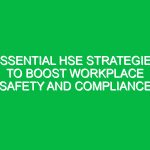# Lead Paint: Recognizing the Dangers and Ensuring Safety
Hello team, and welcome to today’s Toolbox Talk focused on Lead Paint Dangers and Safety. In our line of work, it’s crucial to be aware of the potential risks associated with lead paint and understand how to protect ourselves and our colleagues. By recognizing these dangers and following safety protocols, we can create a safer working environment for everyone.
## Understanding Lead Paint Dangers
Lead paint has been commonly used in buildings for decades, presenting a significant health hazard, especially when disturbed or deteriorating. Exposure to lead paint can lead to serious health issues, including lead poisoning, which can affect the brain, nervous system, and other vital organs. It is important to recognize the signs of lead paint and take necessary precautions to prevent exposure.
### Identifying Lead Paint
Lead paint is often found in older buildings, especially those constructed before 1978 when its use was banned in residential properties. It can be identified by its characteristic odor, taste, and color, which may appear as chips, dust, or flakes. If you suspect lead paint in your work area, notify your supervisor immediately to conduct testing and ensure proper handling.
### Risks of Lead Exposure
Exposure to lead paint can occur through inhalation of lead dust or fumes, ingestion of lead-contaminated materials, or skin contact with lead particles. Even low levels of exposure can have adverse effects on health, particularly in children and pregnant women. Symptoms of lead poisoning may include headaches, fatigue, abdominal pain, and cognitive impairments.
## Ensuring Safety in Lead Paint Work
When working in environments where lead paint is present, it is essential to follow safety protocols to minimize the risk of exposure and protect yourself and your colleagues. Here are some key practices to ensure safety when dealing with lead paint:
### Personal Protective Equipment (PPE)
Wearing the appropriate PPE is crucial when working with lead paint. This may include gloves, coveralls, respirators, and eye protection to prevent skin contact, inhalation, and ingestion of lead particles. Make sure to inspect and maintain your PPE regularly to ensure its effectiveness.
### Containment and Ventilation
Containment measures such as plastic sheeting, barriers, and negative air pressure systems should be used to prevent the spread of lead dust during renovation or demolition activities. Adequate ventilation is also essential to remove airborne contaminants and maintain a safe working environment.
### Safe Work Practices
Follow safe work practices when handling lead paint, such as wetting surfaces before sanding or scraping, using HEPA vacuums for cleanup, and avoiding dry sweeping or blowing lead dust. Minimize the generation of lead dust and debris to reduce the risk of exposure to yourself and others.
## Regulatory Compliance and Standards
In addition to following best practices for lead paint safety, it is important to comply with relevant regulations and standards set forth by occupational health and safety authorities. Familiarize yourself with local regulations, company policies, and industry guidelines to ensure full compliance and minimize legal risks.
## Conclusion
In conclusion, recognizing the dangers of lead paint and ensuring safety is vital to maintaining a healthy work environment. By following proper protocols, wearing PPE, and adhering to safe work practices, we can protect ourselves and our colleagues from the harmful effects of lead exposure. Remember, safety is everyone’s responsibility, and together, we can create a safer workplace for all. Thank you for your attention and commitment to safety.
Remember, when it comes to Lead Paint Dangers and Safety, vigilance and adherence to protocols are key. Stay safe, stay informed, and let’s work together to ensure a hazard-free work environment. Thank you for your attention.


